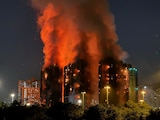According to the organisation, the doomsday clock is "a metaphor".
US President Joe Biden may have pared down his recent warning about a "nuclear Armageddon" but it has brought the "doomsday clock" clock back in sharp focus.
Here is a 5-point guide to the Doomsday Clock's past:
- Established in 1945 by the Bulletin of the Atomic Scientists, a non-profit organisation, the 'Doomsday Clock' symbolically shows how close humans are to destroying the world with "dangerous technologies" -- primarily nuclear bombs. According to the organisation, the clock is "a metaphor, a reminder of the perils we must address if we are to survive on the planet".
- The clock was set at seven minutes to midnight in 1947, two years before the nuclear arms race between the United States and the Soviet Union began. According to the organisation, the clock has moved 24 times in the last 75 years. A group, comprising international scientists and experts, including Nobel laureates, decides whether the clock needs to be reset.
- At 100 seconds to midnight, the clock is currently closest to a prospective global catastrophe. The clock was brought to the present state in January 2020. As per reports, climate change and the threat of a renewed nuclear race, compounded by information warfare, militarisation of space and the development of hypersonic weapons, were reasons for the recent reset of the clock.
- The clock was farthest from midnight in January 1991, following the end of Cold War and the signing of the Strategic Arms Limitation Treaty (SALT) -- 17 minutes to midnight. Interestingly, the clock remained at seven minutes to midnight during the Cuban missile crisis, when the US and USSR came dangerously close to a nuclear war. However, the crisis was resolved before the clock could be reset in January 1963.
- While primarily associated with the threat of a nuclear catastrophe, the 'Doomsday Clock' has over the years also incorporated other threats to humanity like climate change, disruptive technologies etc. Climate change, in particular, has unofficially been a part of the calculations since the 1960s. However, in 2007, climate change was formally added to the clock's settings.
Advertisement















